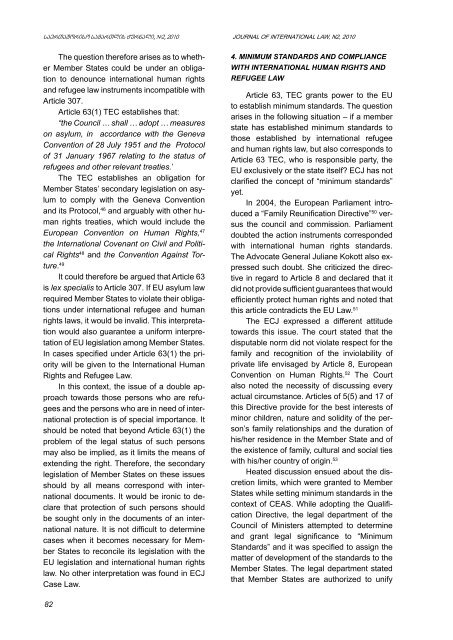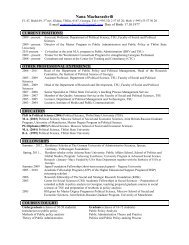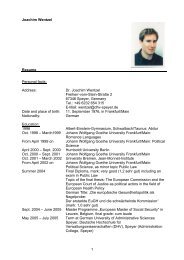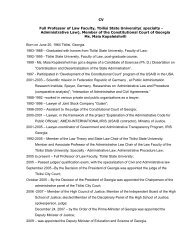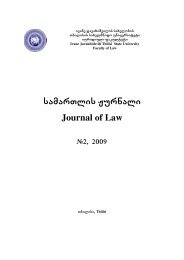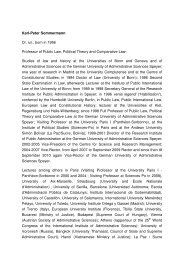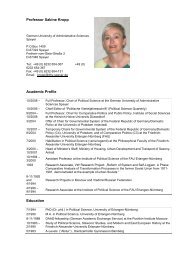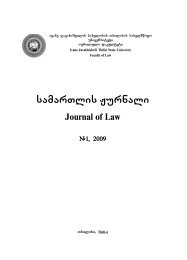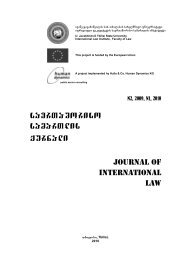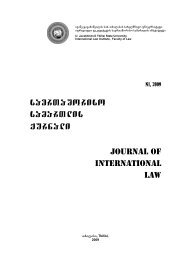Journal International Law_N2-10.indd
Journal International Law_N2-10.indd
Journal International Law_N2-10.indd
You also want an ePaper? Increase the reach of your titles
YUMPU automatically turns print PDFs into web optimized ePapers that Google loves.
saerTaSoriso samarTlis Jurnali, #2, 2010 JOURNAL OF INTERNATIONAL LAW, <strong>N2</strong>, 2010The question therefore arises as to whetherMember States could be under an obligationto denounce international human rightsand refugee law instruments incompatible withArticle 307.Article 63(1) TEC establishes that:“the Council … shall … adopt … measureson asylum, in accordance with the GenevaConvention of 28 July 1951 and the Protocolof 31 January 1967 relating to the status ofrefugees and other relevant treaties.’The TEC establishes an obligation forMember States’ secondary legislation on asylumto comply with the Geneva Conventionand its Protocol, 46 and arguably with other humanrights treaties, which would include theEuropean Convention on Human Rights, 47the <strong>International</strong> Covenant on Civil and PoliticalRights 48 and the Convention Against Torture.49It could therefore be argued that Article 63is lex specialis to Article 307. If EU asylum lawrequired Member States to violate their obligationsunder international refugee and humanrights laws, it would be invalid. This interpretationwould also guarantee a uniform interpretationof EU legislation among Member States.In cases specifi ed under Article 63(1) the prioritywill be given to the <strong>International</strong> HumanRights and Refugee <strong>Law</strong>.In this context, the issue of a double approachtowards those persons who are refugeesand the persons who are in need of internationalprotection is of special importance. Itshould be noted that beyond Article 63(1) theproblem of the legal status of such personsmay also be implied, as it limits the means ofextending the right. Therefore, the secondarylegislation of Member States on these issuesshould by all means correspond with internationaldocuments. It would be ironic to declarethat protection of such persons shouldbe sought only in the documents of an internationalnature. It is not diffi cult to determinecases when it becomes necessary for MemberStates to reconcile its legislation with theEU legislation and international human rightslaw. No other interpretation was found in ECJCase <strong>Law</strong>.4. MINIMUM STANDARDS AND COMPLIANCEWITH INTERNATIONAL HUMAN RIGHTS ANDREFUGEE LAWArticle 63, TEC grants power to the EUto establish minimum standards. The questionarises in the following situation – if a memberstate has established minimum standards tothose established by international refugeeand human rights law, but also corresponds toArticle 63 TEC, who is responsible party, theEU exclusively or the state itself? ECJ has notclarifi ed the concept of “minimum standards”yet.In 2004, the European Parliament introduceda “Family Reunifi cation Directive” 50 versusthe council and commission. Parliamentdoubted the action instruments correspondedwith international human rights standards.The Advocate General Juliane Kokott also expressedsuch doubt. She criticized the directivein regard to Article 8 and declared that itdid not provide suffi cient guarantees that wouldeffi ciently protect human rights and noted thatthis article contradicts the EU <strong>Law</strong>. 51The ECJ expressed a different attitudetowards this issue. The court stated that thedisputable norm did not violate respect for thefamily and recognition of the inviolability ofprivate life envisaged by Article 8, EuropeanConvention on Human Rights. 52 The Courtalso noted the necessity of discussing everyactual circumstance. Articles of 5(5) and 17 ofthis Directive provide for the best interests ofminor children, nature and solidity of the person’sfamily relationships and the duration ofhis/her residence in the Member State and ofthe existence of family, cultural and social tieswith his/her country of origin. 53Heated discussion ensued about the discretionlimits, which were granted to MemberStates while setting minimum standards in thecontext of CEAS. While adopting the Qualifi -cation Directive, the legal department of theCouncil of Ministers attempted to determineand grant legal signifi cance to “MinimumStandards” and it was specifi ed to assign thematter of development of the standards to theMember States. The legal department statedthat Member States are authorized to unify82


